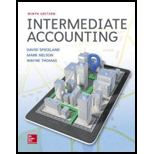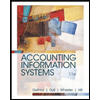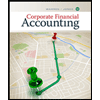
Earnings per share (EPS): The amount of earnings made available to each common share is referred to as earnings per share. Dilutive securities like convertible bonds, convertible
Use the following formula to determine EPS:
To demonstrate: The paradox of increase in EPS while profit decreased with supporting calculations
Explanation of Solution
The following are the main reasons for the paradox of increase in EPS while profit decreased:
- EPS has increased because all the preferred shares ware retired in 2017. Preferred dividends decrease numerator of EPS. Since preferred stock is retired, preferred dividends does not exist to deduct from the numerator, which eventually increases EPS.
- EPS has increased because $50,000,000 convertible debt is retired in 2018. The convertible debt increases the denominator of EPS due to increase in number of shares. Since number of convertible shares is decreased, denominator decreases, which eventually increases EPS.
Supporting computations:
Determine basic EPS of Company DC for the year 2016.
Step 1: Compute the amount of preferred dividends.
Step 2: Compute basic EPS for 2016.
Note: Refer to Equation (1) for value and computation of preferred dividend amount.
Determine diluted EPS of Company DC for the year 2016.
Step 1: Compute interest on bonds.
Step 2: Compute after-tax interest savings due to conversion of outstanding bonds.
Note: Refer to Equation (2) for value and computation of interest on bonds.
Step 3: Compute the total weighted average number of common shares.
| Details | Number of Shares |
| Weighted average number of shares held on December 31, 2015 | 60,000,000 |
| Number of new shares due to bond conversion | 9,000,000 |
| Total weighted average number of shares | 69,000,000 shares |
Table (1)
Step 4: Compute diluted EPS for 2016.
Note: Refer to Equation (1) for value and computation of preferred dividends, Equation (3) for value and computation of after-tax interest savings, and Table (1) for value and computation of weighted average number of common shares outstanding.
Determine basic EPS of Company DC for the year 2017.
Step 1: Compute the amount of preferred dividends for the whole year for 10,000,000 preferred shareholders.
Step 2: Compute the amount of preferred dividends for the half year for 10,000,000 preferred shareholders.
Step 3: Compute weighted average common shares which were retired since March 1, 2017 to December 31, 2017 (10 months).
Step 4: Compute the total weighted average number of common shares.
| Details | Number of Shares |
| Weighted average number of shares held on December 31, 2016 | 60,000,000 |
| Weighted average number of shares retired | (10,000,000) |
| Total weighted average number of shares | 50,000,000 shares |
Table (2)
Note: Refer to Equation (6) for value and computation of weighted average number of shares retired.
Step 5: Compute basic EPS for 2017.
Note: Refer to Equations (4) and (5) for value and computation of preferred dividend amounts, and Table (2) for value and computation of weighted average number of common shares outstanding.
Determine diluted EPS of Company DC for the year 2017.
Step 1: Compute the total weighted average number of common shares.
| Details | Number of Shares |
| Weighted average number of shares held on December 31, 2016 | 60,000,000 |
| Weighted average number of shares retired | (10,000,000) |
| Number of new shares due to bond conversion | 9,000,000 |
| Total weighted average number of shares | 59,000,000 shares |
Table (3)
Note: Refer to Equation (6) for value and computation of weighted average number of shares retired.
Step 2: Compute diluted EPS for 2017.
Note: Refer to Equations (4) and (5) for value and computation of preferred dividend amounts, Equation (3) for value and computation of after-tax interest savings, and Table (3) for value and computation of weighted average number of common shares outstanding.
Determine basic EPS of Company DC for the year 2018.
Step 1: Compute the total weighted average number of common shares.
| Details | Number of Shares |
| Weighted average number of shares held on December 31, 2017 | 60,000,000 |
| Weighted average number of shares retired | (10,000,000) |
| Number of shares retired | (12,000,000) |
| Total weighted average number of shares | 38,000,000 shares |
Table (4)
Note: Refer to Equation (6) for value and computation of weighted average number of shares retired.
Step 2: Compute basic EPS for 2018.
Note: Refer to Table (4) for value and computation of weighted average number of common shares outstanding.
Determine diluted EPS of Company DC for the year 2018.
Note: Refer to Table (4) for value and computation of weighted average number of common shares outstanding.
Want to see more full solutions like this?
Chapter 19 Solutions
Intermediate Accounting
- Contingent liabilities Altria Group, Inc., has more than 12 pages dedicated to describing contingent liabilities in the notes to recent financial statements. These pages include extensive descriptions of multiple contingent liabilities. Use the Internet to research Altria Group, Inc., at www.altria.com. a. What are the major business units of Altria Group? b. Based on your understanding of this company, why would Altria Group require more than 12 pages of contingency disclosure?arrow_forwardInvestment reporting O'Brien Industries Inc. is a hook publisher. The comparative unclassified balance sheets for December 31, Year 2 and Year 1 follow. Selected missing balances are shown by letters. Brien Industries Inc. Balance Sheet December 31, Year 2 and Year 1 Dec. 31, Year 2 Dec 31, Year 1 cash 233,000 220,000 Accounts receivable (net) 136,530 138,000 Available for sale investments (at cost)Note 1 a 103,770 Less valuation allowance for available-for-sale investments b. 2,500 Available for-sale investments (fair value) c 101,270 Interest receivable d Investment in Jolly Roger Co. stockNote 2 e. 77,000 Office equipment (net) 115,000 130,000 Total assets f. 666,270 Accounts payable 69.400 65,000 Common stock 70.000 70,000 Excess of issue price over par 225,000 225,000 Retained earnings g 308,770 Unrealized gain (loss) on available for-sale investments h. (2,500) Total liabilities and Stockholders equity i. 666,270 Note 1. Investments are classified as available for sale. The investments at cost and fair value on December 31, Year 1, are as follows: No. of Shares Cost per Share Total Cost Total Fair Value Bernard Co. stock 2,250 17 38,250 37,500 Chadwick Co. stock 1,260 52 65,520 63,770 103,770 101,270 Note 2. The investment in Jolly Roger Co. stock is an equity method investment representing 30% of the outstanding .shares of Jolly Roger Co. The following selected investment transactions occurred during Year 2: May 5. Purchased 3,080 shares of Gozar Inc. at 30 per share including brokerage commission. Gozar Inc. is classified as an available-for-sale security. Oct. 1. Purchased 40,000 of Nightline co. 6%, 10-Year bonds at 100. The bonds are classified as available for sale. The bonds pay interest on October 1 and April 1. 9. Dividends of 12,500 are received on the Jolly Roger co. investment. Dec. 31 Jolly Roger co. reported a total net income of 112,000 for year 2. O'Brien industries Inc. recorded equity earnings for its share of Jolly Roger co. net income. 31. Accrued three months of interest on the Nightline bonds. 31. Adjusted the available-for-sale investment portfolio to fair value, using the following fair value per-share amounts: Available-for-Sale Investments Fair Value Bernard Co. stock 15,40 per share Chadwick Co. stock 46,00 per share Gozar Inc. stock 32,00 per share Nightline Co. bonds 98 per 100 of face amount Dec. 31. Closed the OBrien Industries Inc. net income of 146,230. O'Brien Industries Inc. paid no dividends during the year. Instructions Determine the missing letters in the unclassified balance sheet. Provide appropriate supporting calculations.arrow_forwardChapter 6 Question 11 I know the answer is also not -6,792arrow_forward
- Pls answer number 15 with solutions An entity is the defendant in a patent infringement lawsuit. The entity’s lawyers believe there is a 30% chance that the court will dismiss the case and the entity will incur no outflow of economic benefits. However, if the court rules in favor of the claimant, the lawyers believe that there is a 20% chance that the entity will be required to pay damages of ₱800,000 (the amount sought by the claimant) and an 80% chance that the entity will be required to pay damages of ₱400,000 (the amount that was recently awarded by the same judge in a similar case). Other outcomes are unlikely. The court is expected to rule in late December 20x2. There is no indication that the claimant will settle out of court. A 7% risk adjustment factor to the probability-weighted expected cash flows is considered appropriate to reflect the uncertainties in the cash flow estimates. An appropriate discount rate is 10% per year. How much is the provision for lawsuit at…arrow_forward10. LO 12.3If a bankruptcy is deemed likely to occur and is reasonably estimated, what would be the recognition and disclosure requirements for the company?arrow_forwardDiscussion: Ch. 23 5 5 unread replies. 5 5 replies. Dash Riprock is a cost analyst with Safe Insurance Company. Safe is applying standards to its claims payment operations. Claims payment is a repetitive operation that could be evaluated with standards. Dash used time and motion studies to identify an ideal standard of 36 claims processed per hour. The Claims Processing Department manager, Henry Tudor, has rejected this standard and has argued that the standard should be 30 claims processed per hour. Henry and Dash were unable to agree, so they decided to discuss this matter openly at a joint meeting with the Vice President of Operations, who would make a final decision. Prior to the meeting, Dash wrote the following memo to the Vice President: To: Anne Boleyn, Vice President of Operations From: Dash Riprock Re: Standards in the Claims Processing Department As you know, Henry and I are scheduled to meet with you to discuss our disagreement about…arrow_forward
- RD.16. I cannot figure out what the minimum years of service would be.. thanks!.arrow_forwardInvestment reporting Teasdale Inc. manufactures and sells commercial and residential security equipment. The comparative unclassified balance sheets for December 31, Year 2 and Year 1 are provided below. Selected missing balances are shown by letters. Teasdale Inc. Balance Sheet December 31, Year 2 and Year 1 Dec. 31, Year 2 Dec. 31, Year 1 Cash 160,000 156,000 Accounts receivable (net) 11S.OOO 108,000 Available for-sale investments (at cost)Note 1 a. 91,200 Plus valuation allowance for available-for-sale investments b. 8,776 Available for-sale investments (fair value) c 99,976 Interest receivable d. Investment in Wright Co. stockNote 2 e. 69,200 Office equipment (net) 96,000 105,000 Total assets f. 5538,176 Accounts payable 91,000 72,000 Common stock 80,000 80,000 Excess of issue price over par 250,000 250,000 Retained earnings g 127,400 Unrealized gain (loss) on available for-sale investments h. 8,776 Total liabilities and stockholders' equity S i. 5538,176 Note 1. Investments are classified as available for sale. The investments at cost and fair value on December 31, Year 1, are as follows: No. of Shares Cost per Share Total Cost Total Fair Value Alvarez Inc stock 960 38,00 36,480 39,936 Hirsch Inc. stock 1,900 28,80 4,720 60,040 91,200 99,976 Note 2. The Investment in Wright Co. stack is an equity method investment representing 30% of the outstanding shares of Wright Co. The following selected investment transactions occurred during Year 2: Mar. 18. Purchased 800 shares of Richter Inc. at 40, including brokerage commission. Richter is classified as an available-for-sale security. July 12. Dividends of 12,000 art: received on the Wright Co. investment. Oct 1. Purchased 24,000 of Toon Co. 4%, 10-year bonds at 100. the bonds are classified as available for sale. The bonds pay interest on October 1 and April 1. December 31. Wright Co. reported a total net income of 80,000 for Year 2. Teasdale recorder equity earnings for its share of Wright Co. net income. 31. Accrued interest for three months on the Toon Co. bonds purchased on October 1. 31. Adjusted the available-for-sale investment portfolio to fair value, using the following fair value per-share amounts: Available for Sale Investments Fair Value Alvarez Inc. stock 41,50 per share Hirsch Inc stock 26,00 per share Richter Inc. stock 48,00 per share Toon Co. bonds 101 per 100 of face amount 31. Closed the Teasdale Inc. net income of 51,240. Teasdale Int. paid no dividends during the year. Instructions Determine the missing letters in the unclassified balance sheet. Provide appropriate supporting calculations.arrow_forwardA2 7b May I please have the answer in formula form and not excel. thx:) 7. You are making plans for your retirement. You have just turned 30 and want to retire on your 65th birthday. Once retired, you plan to move to a tax-free Caribbean state, where you believe you can live comfortably on your retirement savings. You plan to make your first withdrawal from your retirement savings when you retire at age 65 and your last withdrawal one month before your 85th birthday. Based on family history, you expect to live until exactly age 85. Your plan is to have a total of $1 million when you retire. Your current salary is $36,000 per year, or $3,000 per month. Your personal tax rate is approximately 30%. You estimate that you can earn an average return of 12% APR compounded annually on any money you invest over the next 60 years. You want to start putting aside a fixed amount of money at the end of every month until your retirement at age 65. You will make your first deposit one month from now…arrow_forward
 AccountingAccountingISBN:9781337272094Author:WARREN, Carl S., Reeve, James M., Duchac, Jonathan E.Publisher:Cengage Learning,
AccountingAccountingISBN:9781337272094Author:WARREN, Carl S., Reeve, James M., Duchac, Jonathan E.Publisher:Cengage Learning, Financial & Managerial AccountingAccountingISBN:9781285866307Author:Carl Warren, James M. Reeve, Jonathan DuchacPublisher:Cengage Learning
Financial & Managerial AccountingAccountingISBN:9781285866307Author:Carl Warren, James M. Reeve, Jonathan DuchacPublisher:Cengage Learning Accounting (Text Only)AccountingISBN:9781285743615Author:Carl Warren, James M. Reeve, Jonathan DuchacPublisher:Cengage Learning
Accounting (Text Only)AccountingISBN:9781285743615Author:Carl Warren, James M. Reeve, Jonathan DuchacPublisher:Cengage Learning Accounting Information SystemsFinanceISBN:9781337552127Author:Ulric J. Gelinas, Richard B. Dull, Patrick Wheeler, Mary Callahan HillPublisher:Cengage Learning
Accounting Information SystemsFinanceISBN:9781337552127Author:Ulric J. Gelinas, Richard B. Dull, Patrick Wheeler, Mary Callahan HillPublisher:Cengage Learning Corporate Financial AccountingAccountingISBN:9781337398169Author:Carl Warren, Jeff JonesPublisher:Cengage Learning
Corporate Financial AccountingAccountingISBN:9781337398169Author:Carl Warren, Jeff JonesPublisher:Cengage Learning




